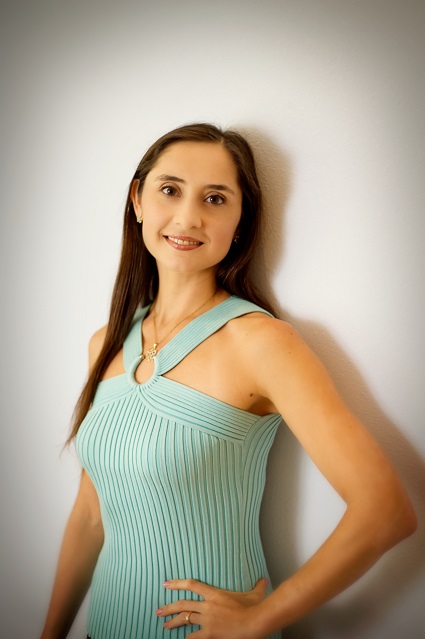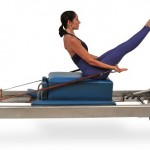When I was about fifteen years old my ballet school started to offer Pilates mat classes. This sounds great to me now, but back then I was a bunhead that only had time for ballet. I remember cutting many of those Pilates mat classes to practice my pointe work in an empty studio within the same building. But fortunately the extra studios were not always empty so I ended up taking enough Pilates classes to learn the mat routine by heart. Later, when I became a professional dancer I turned to Pilates for conditioning and grew to appreciate this amazing method.
Although Pilates served me well through my dance career, looking back I realize that I was just going through the motions in my matwork. For example I approached side leg kicks up and down like a karate kick in the air. When I entered the Pilates program for teacher certification Pilates became complicated and full of nuances. Side kicks up and down became more than just a leg movement, I had to stack my hips and pay attention to keeping my top hip aligned over the bottom hip as the top leg went up into the air (that diminished the height of my leg by at least half). I had to keep the leg in the air hovering directly over the bottom leg while rotating the leg out in Pilates stance. I had to reach long from my hips without locking my knees. I had to keep my focus straight ahead with the back of my neck long instead of lowering my chin to look down at my toes.
I have been teaching Pilates for fifteen years now and I have come to realize that at a certain point analyzing the exercises can take away from the desired benefit. I often tell students who have been studying Pilates for a while that analysis can be paralysis. If they concentrate too much they will become rigid and their bodies will not move with fluidity. In a way, the side leg kicks are just a leg movement up and down but you can only approach it that way after you go through that excruciating stage of analyzing the nuances. By applying this concept of simplicity to your Pilates work, learning the method will come full circle.
PILATES SIMPLIFIED
There is a Dr. Seuss quote I absolutely adore: “Sometimes the questions are complicated and the answers are simple.” I used to find the question “What is Pilates?” a complicated question to answer until Romana described it in three simple words: Pilates is STRETCH, STRENGTH and CONTROL. This is a fantastic way to describe Pilates to people quickly when you’re at a party and you’ve just been introduced as the Pilates teacher or when you have a potential new student inquiring about Pilates over the phone, but over the years I have found another way to describe Pilates more fully to people once I get them into the studio.
As teachers we see how Joe Pilates recycled the exercises from the mat to the different pieces of equipment. I have noticed that the movements can be broken down into three categories: deepening the powerhouse, articulating the spine and opening the chest. I find that breaking Pilates down into these three categories helps students see Pilates as a complete method that is within their grasp rather than an immense series of exercises full of nuances. If you think about it every Pilates exercise will focus on at least one of these three movements. Let’s take the long box series:
The pulling straps help us open the chest (stretch).
The backstroke deepens our powerhouse (strength).
And rolling into and out of the teaser develops our articulation of the spine (control).
Describing Pilates in these three categories appeals to everyone. Most students come to Pilates looking for better posture (open the chest), a stronger core (deepening the powerhouse), and/or better mobility in their back (articulation of the spine).
 The wall series was probably Romana’s favorite ending exercise. She told us to do it every week. The arm circles help open the chest (with the added challenge of keeping the back anchored to the wall), the peel down is our articulation of the spine, and the skiing forces us to deepen our powerhouse strength as we come out of the squat (it is easier to keep our back anchored to the wall when the legs are bent in a squat position, but as soon as the legs begin to stretch we need to button our bellybuttons deeper into the wall to keep contact). I think there is a reason the wall series was one of Romana’s favorite exercises. It gets all three of the major components of the Pilates lesson previously performed lying down or sitting and transfers them into a vertical position. The wall series is a great way to end the lesson and a fantastic way to start the rest of our day.
The wall series was probably Romana’s favorite ending exercise. She told us to do it every week. The arm circles help open the chest (with the added challenge of keeping the back anchored to the wall), the peel down is our articulation of the spine, and the skiing forces us to deepen our powerhouse strength as we come out of the squat (it is easier to keep our back anchored to the wall when the legs are bent in a squat position, but as soon as the legs begin to stretch we need to button our bellybuttons deeper into the wall to keep contact). I think there is a reason the wall series was one of Romana’s favorite exercises. It gets all three of the major components of the Pilates lesson previously performed lying down or sitting and transfers them into a vertical position. The wall series is a great way to end the lesson and a fantastic way to start the rest of our day.
The next time you have a student looking for a way to describe Pilates beyond the three words of stretch, strength and control, just break it down for them into these three different categories. It may help them focus on the bigger picture and help them squeeze the juice out of each exercise instead of just tickling the surface. There may be hundreds of Pilates exercises but if we step back and really look at them they easily fit into one or more of these three categories. There are many ways to open the chest, deepen the powerhouse and articulate the spine on the various pieces of equipment and the genius of Joseph Pilates was that he found a way to drill these three concepts into our movement without leaving us bored.
 A dual citizen of Brazil and the United States, Christina Maria Gadar, has been specializing in private instruction of the original Pilates Method in her Sarasota, Florida studio, since 2000. Trained and certified by Joseph Pilates’ protégé, Romana Kryzanowska, Christina has a true love for, and devotion to the Pilates Method.She is the author ofPilates: An Interactive Workbook currently available atAmazon and she is currently working on a new Pilates guide for teaching young children ages 6-11
A dual citizen of Brazil and the United States, Christina Maria Gadar, has been specializing in private instruction of the original Pilates Method in her Sarasota, Florida studio, since 2000. Trained and certified by Joseph Pilates’ protégé, Romana Kryzanowska, Christina has a true love for, and devotion to the Pilates Method.She is the author ofPilates: An Interactive Workbook currently available atAmazon and she is currently working on a new Pilates guide for teaching young children ages 6-11
www.pilatespersonaltraining.com






